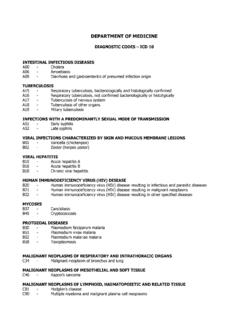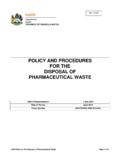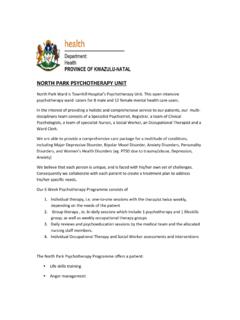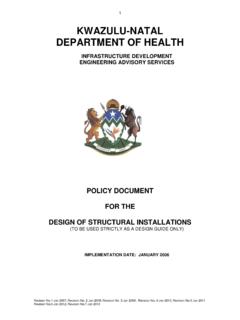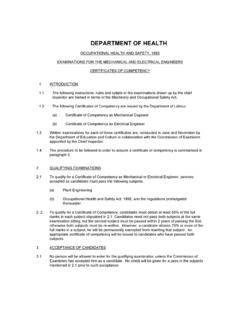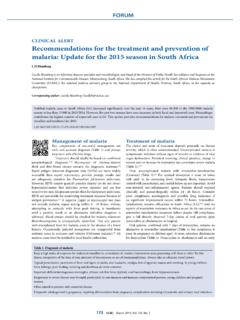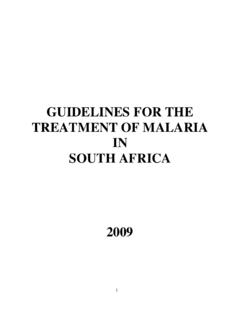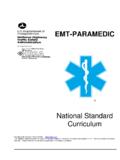Transcription of GUIDELINES for Chronic Renal Dialysis - …
1 GUIDELINES . for Chronic Renal Dialysis health department : Health REPUBLIC OF SOUTH AFRICA. CONTENTS. PAGE. Foreword .. ii 1. INTRODUCTION .. 01. OBJECTIVES .. 01. 2. PRINCIPLES .. 02. 3. EXCLUSION CRITERIA .. 03. Medical Exclusion Criteria .. 03 Psychological Exclusion Criteria .. 04. Compliance .. 04. APPENDIX .. 05. Dialysis IN PATIENTS WITH HIV .. 05. 1. Introduction .. 05. 2. Dialysis in patients with HIV .. 06. Heamodialysis .. 07. Peritoneal Dialysis .. 08. 3. Challenges and recommendations .. 09. ACRONYMS .. 10. i FOREWORD. End stage kidney disease is increasing amongst South Africans. Dialysis is the first form of intervention to patients affected by kidney failure. If patients do not get kidney donors they can wait for a long time on Dialysis and that places a heavy burden on national resources. It also makes it difficult for clinicians to decide who can be accepted onto the program.
2 The health system in South Africa, like in other countries, is characterized by the existence of both a private and the public sector with different financial and human resources. This has to a large extent contributed to the unequal access to Chronic Renal Dialysis for our people. The main objective of these GUIDELINES is to assist the clinicians when making decisions particularly on older patients and those affected by HIV taking into consideration the resources available to them. It is my hope that these GUIDELINES will contribute towards the realization of the goals of the government of improving health service delivery and ensuring a better life for all. MS BARABARA HOGAN, MP. MINISTER OF HEALTH. DATE: ii 1. INTRODUCTION. It is the aim of the health services of South Africa to provide all South African citizens and permanent residents equitable access to Chronic Renal Dialysis .
3 Dialysis is a method of removing waste products from the body for patients with kidney failure. The settings where Dialysis is undertaken are: Hospitals, satellites units and homes. These GUIDELINES must therefore be used to make efficient use of limited resources and assist clinicians to decide who should be accepted onto the programme and who should not. Patients who do not satisfy these criteria but who are nevertheless accepted on to a Chronic Renal Dialysis programme in the private sector, should remain the responsibility of the private sector. Kidney transplantation is the choice for many patients, about a third is not suitable for transplantation and the supply of donor organs is limited. However, due to the lack of resources, it has to be accepted that there is a need to set boundaries for medical treatment, including Renal Dialysis .
4 OBJECTIVES: The main objectives of the GUIDELINES are as follows: To optimize the use of scarce resources. To promote cost- effectiveness. To promote public/private partnership. To improve services to users 01. 2. PRINCIPLES. Unlike the public sector, Renal transplantation should not be the major criterion for acceptance for Chronic Dialysis in the private sector. Individual patients with diabetes and patients with acceptable co-morbid conditions may be considered for long-term Renal Dialysis although research shows that they do not respond well in the long term. Patients who satisfy the set criteria and are accepted onto a Chronic Dialysis programme in the private sector should remain the responsibility of the private sector provider unless there is timeous and specific agreement between the public and private sector to shift the responsibility.
5 Treatment options for Chronic Dialysis should be discussed with the patient and the family. They should be allowed to choose the technique that is optimal for the patient with due consideration of medical, social and geographic factors. Treatment that is offered should be cost- effective. In order to make informed choice the potential impact on the patient's life and that of the families should be explained. Physical and psychological symptoms related to Chronic Renal Dialysis should be treated appropriately and monitored. Public Private Partnerships should be encouraged as a model for service delivery in Chronic Renal Dialysis . The service providers must take reasonable measures, within its available resources, to achieve the progressive realization of the services to be offered. 02. 3. EXCLUSION CRITERIA. Exclusion rather than inclusion criteria should be applied for the selection of a suitable patient.
6 Before it is decided that Dialysis is a suitable option for an individual there should be a full assessment of the patient's healthcare needs such as economic, social, school and work circumstances. The consequences of long- term Dialysis are significant on the patient and their families. Medical exclusion criteria Active, uncontrollable malignancy or with short life expectancy Advanced, irreversible progressive disease of vital organs such as: o cardiac, cerebrovascular or vascular disease o advanced cirrhosis and liver disease o medically or surgically irreversible coronary artery disease o lung disease o unresponsive infections , HPV, Hepatitis B and C. HIV and AIDS are not a medical exclusion criteria provided the patient has access to a comprehensive AIDS treatment plan including antiretroviral treatment and stable for at least six months and the above exclusion factors are absent.
7 03. Age (provided above exclusion factors are absent) is not a contra- indication for Chronic Renal Dialysis . In the UK the median age of starting Renal replacement therapy is 63 years and the median age of the population is 54 years. Psychological Exclusion Criteria Any form of mental illness that has resulted in diminished capacity for patients to take responsibility to their actions. Active substance abuse or dependency including tobacco use. Obesity Compliance Patients with proven habitual non-compliance with Dialysis treatment and lifestyle modification will be excluded or removed from Chronic Renal Dialysis programme 04. APPENDIX. Dialysis IN PATIENTS WITH HIV INFECTION. 1. Introduction HIV infection is common in South Africa and presents our society with numerous challenges. HIV can cause Chronic kidney disease (CKD). and can contribute significantly to the burden of patients requiring Renal replacement therapy (RRT).
8 HIV associated nephropathy (HIVAN) was the third commonest cause of end stage Renal failure (ESRF) in black patients in the USA after hypertension and diabetes, and since the availability of antiretroviral therapy (ART) is now in 7th place (USRDS, 2006) Furthermore HIV infection may co-exist with end stage Renal failure of any other cause and we have even experienced instances of seroconversion to HIV positive of patients already on Dialysis . In South Africa RRT is not freely available Patients who can afford it or who have medical insurance may be able to receive these expensive therapies in the private sector For the majority, however this service is not freely available and is provided to a select few in some state hospitals Patients are selected for Dialysis based on state criteria for acceptance to a transplant programme Even if patients with ESRF fulfil the state criteria most centres are limited by the availability of slots' for Dialysis These are defined by the institution based on availability of funds, staff and equipment.
9 Because the optimal form of RRT is Renal transplantation, Dialysis is seen as a bridge to transplant and the state criteria' are underpinned by the transplantability' of the patient Any guideline on Dialysis would have to keep this approach in mind and the availability Dialysis for HIV positive patients will be contingent on our ability to transplant them. 05. 2 Dialysis in HIV positive patients. In the pre-HAART era the survival of most patients with advanced HIV. infection was dismal. Similarly for patients with HIV infection on Dialysis the outcome was poor even in the developed world This led some to recommend withholding Dialysis from these patients. After the advent of anti-retrovirals however several retrospective studies in Europe and the USA have confirmed survival rates in the short term which are similar to the non-infected non-diabetic population However predictors of poor outcome include Low CD4 counts High viral loads HIVAN as the cause of ESRF.
10 Absence of HAART. Opportunistic infections. Given the finding that survival of HIV positive patients receiving HAART. is similar to non-infected Dialysis patients it has been recommended by GUIDELINES in both the USA and Britain that Dialysis not be withheld from these patients on the basis of their HIV serostatus. However the survival of HIV positive patients on HAART on Dialysis is still worse than that of the general HIV positive population Studies have shown a more rapid progression of HIV infection in patients with kidney failure and the presence of kidney disease either in the form of proteinuria or a raised creatinine portends a poorer outcome for the patient. This has led to the initiation of transplantation in stable HIV positive patients with encouraging early results. 06. Both haemodialysis (HD) and peritoneal Dialysis (PD) have been employed in these patients.
